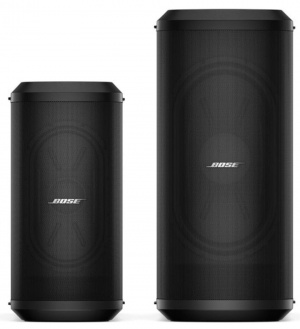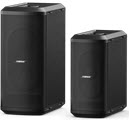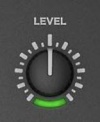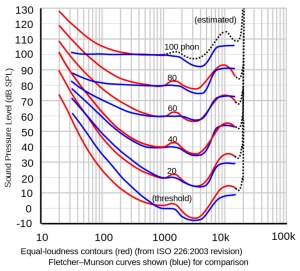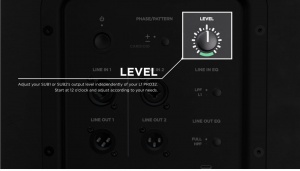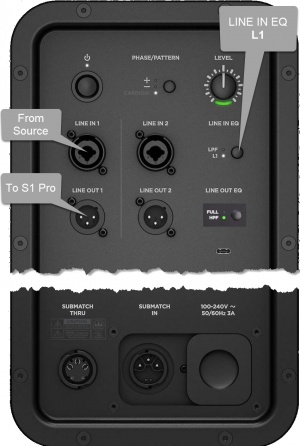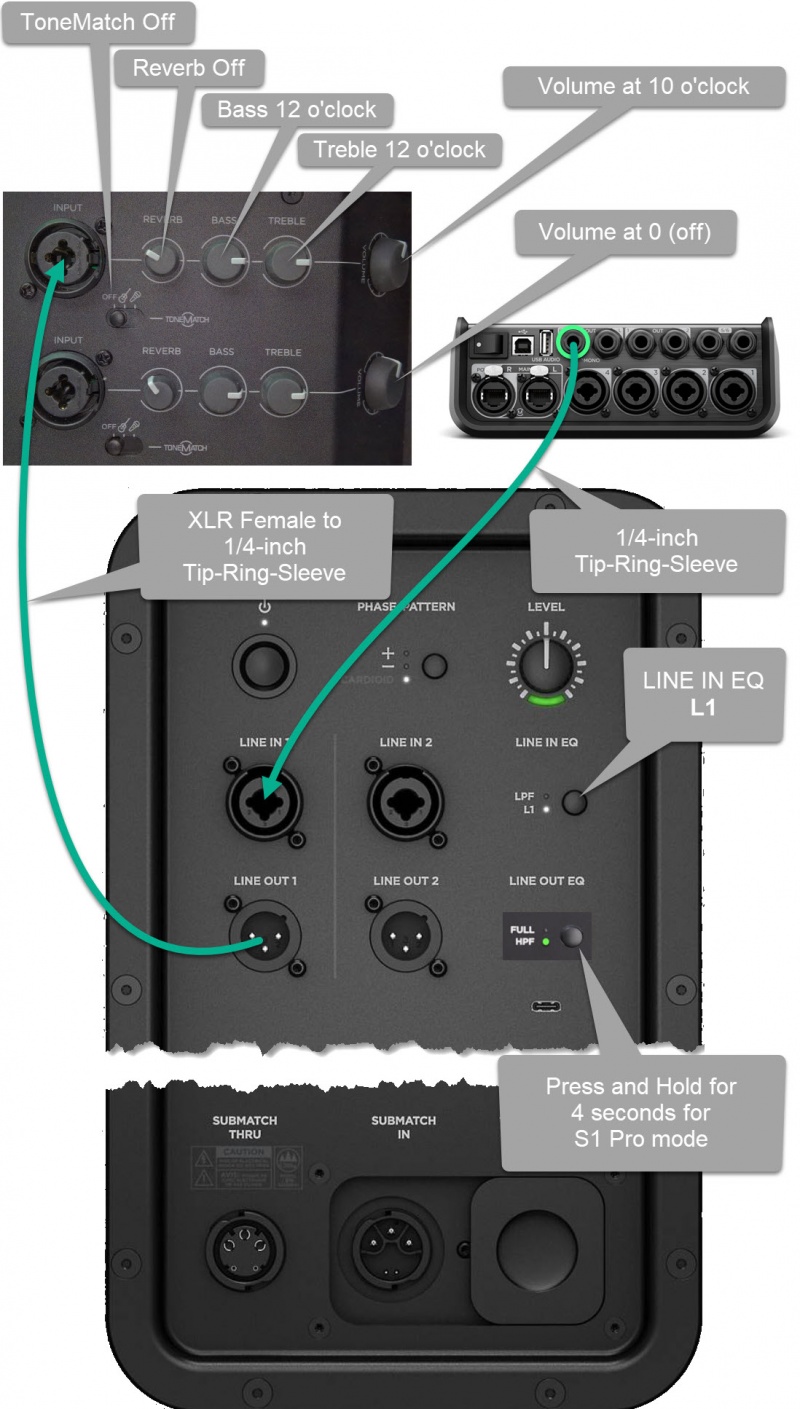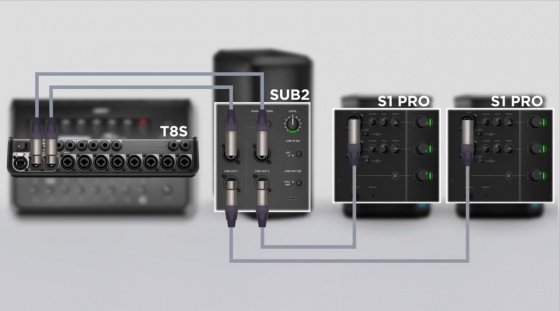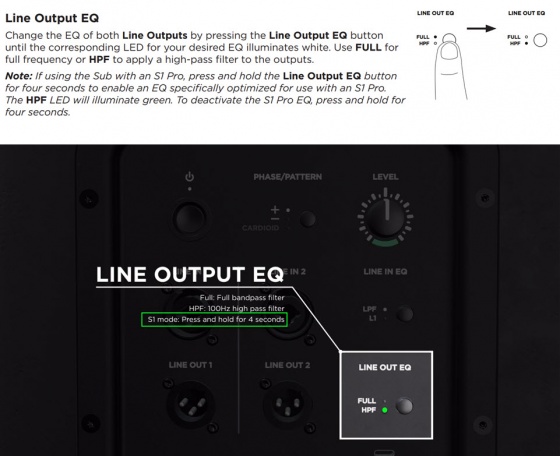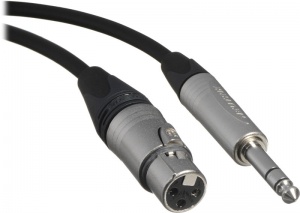Sub1/Sub2
Introduction
Introduced: October 2020
First available: January 2021
Use the Sub1 or Sub 2 bass modules with the Bose L1 Pro32
- Sub1 creates a compact system (down to 40 Hz)
- Sub2 plays lower and louder (down to 37 Hz)
- Extreme portability using RaceTrack drivers
Use the Sub1 or Sub 2 bass modules other PA systems (e.g., Bose S1 Pro or third-party systems)
Documentation
Training
Comparisons Sub1/Sub2
| Specification | B1 | B2 | Sub1 | Sub2 | F1 Subwoofer |
|---|---|---|---|---|---|
| dB SPL at 1 meter Continous/Peak |
n/a | 115 dB/121 dB | 118 dB/124 dB | 123 dB/129 dB | 124 dB/130 dB |
| Watts RMS Active/Passive |
125 Passive |
250 Passive |
480 Active |
1000 Active |
1000 Active |
| Weight pounds | 28 | 45 | 35.5 | 51.7 | 55 |
| Drivers | Two 5.25" | Two 10" | One 7"x10" race track | One 10"x18" race track | Two 10" |
| Cardioid Mode | n/a | n/a | Yes | Yes | n/a |
| Compatibility with Bose Products | L1 Legacy | L1 Legacy | L1 Pro, L1 Legacy, S1 Pro, L1 Compact | L1 Pro, L1 Legacy, S1 Pro, L1 Compact | L1 Pro, L1 Legacy, S1 Pro, L1 Compact |
| Compatibility with non-Bose products | No passive, no low-pass filter |
No passive, no low-pass filter |
Yes active, switchable low-pass filter |
Yes active, switchable low-pass filter |
Yes active, switchable high-pass filter |
Level Control
- Question
- Why have a LEVEL control on the Bose Sub1/Sub2? This can also apply to other subwoofers as well.
- Answer
At lower volume, the Equal Loudness contour[1] shows that humans don't perceive bass as well as mid-highs. You can compensate for this by turning up the Sub1/Sub2 LEVEL Control.
Other times bass may seem excessive
- At higher volumes
- Due to boundary effects (proximity to walls and corners)
- On a resonant stage
You can compensate for this by turning down the Sub1/Sub2 LEVEL Control.
- Set the Sub1/Sub2 Level control at 12:00 o'clock[2].
- Raise/lower the volume of the L1 Pro32 as required.
- Adjust the Sub1/Sub2 Level control to balance bass level with the mid-high level from the L1 Pro 32.
Cardioid Mode
Stack two Sub1 or Sub2 subwoofers in Cardioid Mode for focused, directional performance with reduced rear-firing bass energy (-10 dB SPL). This steers the bass out front, and reduces feedback. This is particularly useful when you have resonant instruments on the stage (e.g., kick drum, upright bass).
Cooling
- Question
How are the Sub1/Sub2 cooled?
- Answer
Sub1 and Sub2 have extruded aluminum heat sinks mounted to the backside of the I/O panel. This pulls heat out of the electronics and transfers some to the air moving through the acoustic volume of the sub and helps to cool.[3]
S1 Pro system with Sub1/Sub2
Preferred Method
Connections with Sub1 or Sub2 and the S1 Pro system
For best results, the signal flow should go from
- The signal source (e.g., ToneMatch Mixer[4], mixer, DJ console) output to
- The Sub1 or Sub2 subwoofer LINE IN 1 ()
- The Sub1 or Sub2 subwoofer LINE OUT 1 to
- The S1 Pro system with channel volume set to 10 o'clock.
- Note these settings on the Sub1 or Sub2
- 👉 Set LINE IN EQ to L1
- 👉 Set LINE OUT EQ to S1 (Press and hold LINE OUT EQ button for 4 seconds)
Set up this way,
- The Sub1 or Sub2 handles frequencies from 40 Hz (Sub1) 37 Hz (Sub2) to 150 Hz
- The S1 Pro system handles frequencies above 150 Hz
- Mono - Example with a T4S as the audio source
- Start with the Volume on S1 Pro and Sub, as shown. Adjust as necessary from there.
The picture shows a stereo setup. The signal flow is from left to right.
- Recommended cable
Use an XLR to 1/4 inch (6.35 mm) Tip-Ring-Sleeve cable for best results.
If you use an XLR to XLR cable, the signal may be too hot for the S1 Pro system.
Alternative Connection
- Can I connect the S1 Pro Line Out to the Sub?
The method described above is preferred, but you can use the S1 Pro system as the sound source (e.g., microphone and guitar and backing tracks via Bluetooth) Note the following:
- The S1 Pro system will sound the same as without the subwoofer (62 Hz - 17 kHz)
- The Sub1 or Sub2 will cover from 40 Hz (Sub1) 37 Hz (Sub2) to 150 Hz
- You will be able to push S1 Pro system harder (louder) if you route the signal as described at the top of this article
